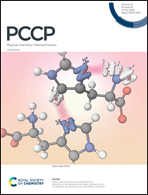Acetylene hydrogenation catalyzed by bare and Ni doped CeO2(110): the role of frustrated Lewis pairs†
Abstract
Ceria (CeO2) has recently been found to catalyze the selective hydrogenation of alkynes, which has stimulated much discussion on the catalytic mechanism on various facets of reducible oxides. In this work, H2 dissociation and acetylene hydrogenation on bare and Ni doped CeO2(110) surfaces are investigated using density functional theory (DFT). Similar to that on the CeO2(111) surface, our results suggest that catalysis is facilitated by frustrated Lewis pairs (FLPs) formed by oxygen vacancies (Ovs) on the oxide surfaces. On bare CeO2(110) with a single Ov (CeO2(110)–Ov), two surface Ce cations with one non-adjacent O anion are shown to form (Ce3+–Ce4+)/O quasi-FLPs, while for the Ni doped CeO2(110) surface with one (Ni–CeO2(110)–Ov) or two (Ni–CeO2(110)–2Ov) Ovs, one Ce and a non-adjacent O counterions are found to form a mono-Ce/O FLP. DFT calculations indicate that Ce/O FLPs facilitate the H2 dissociation via a heterolytic mechanism, while the resulting surface O–H and Ce–H species catalyze the subsequent acetylene hydrogenation. With CeO2(110)–Ov and Ni–CeO2(110)–2Ov, our DFT calculations suggest that the first hydrogenation step is the rate-determining step with a barrier of 0.43 and 0.40 eV, respectively. For Ni–CeO2(110)–Ov, the reaction is shown to be controlled by the H2 dissociation with a barrier of 0.41 eV. These barriers are significantly lower than that (about 0.7 eV) on CeO2(111), explaining the experimentally observed higher catalytic efficiency of the (110) facet of ceria. The change of the rate-determining step is attributed to the different electronic properties of Ce in the Ce/O FLPs – the Ce f states closer to the Fermi level not only facilitate the heterolytic dissociation of H2 but also lead to a higher barrier of acetylene hydrogenation.



 Please wait while we load your content...
Please wait while we load your content...